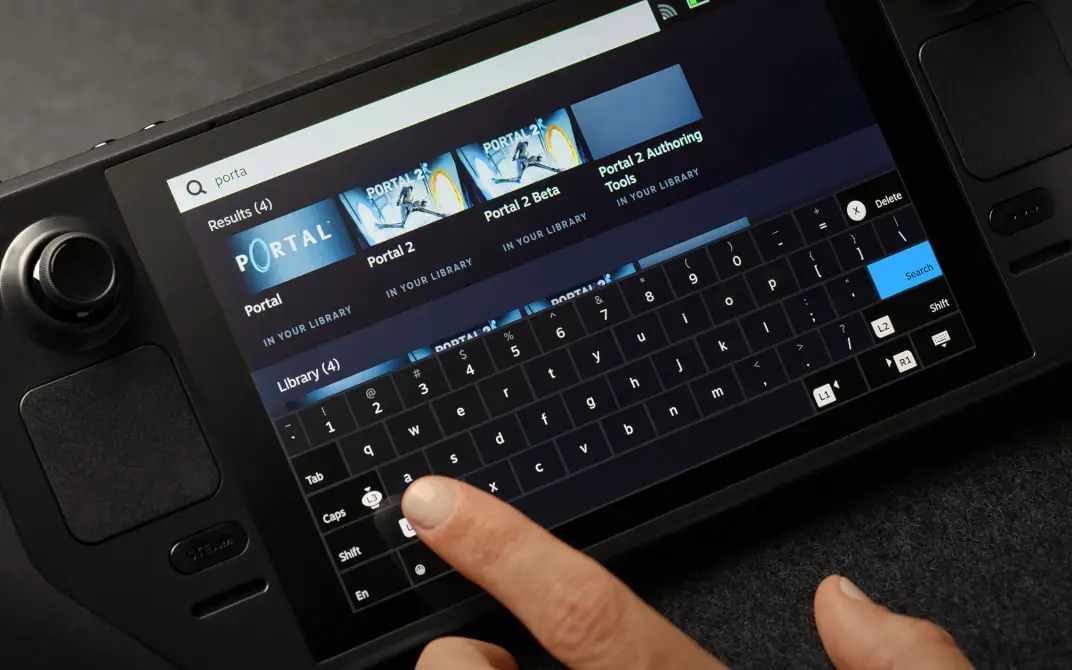What if you could play any PC game on a handheld device? That’s the idea behind the Steam Deck, a new product from Valve that aims to bring the best of PC gaming to a portable format. But is it really a game-changer for PC gaming on the go?
Steam Deck Specs and Features
Valve, the company that created popular games like Half-Life, Portal, and Dota 2, has designed the Steam Deck – a handheld device that aims to bring the full power of PC gaming to a portable form factor. Here are its features and specs.
- Processor: AMD APU with Zen 2 4c/8t CPU (2.4-3.5GHz) and 8 RDNA 2 CUs GPU (1.0-1.6GHz)
- RAM: 16 GB LPDDR5 on-board RAM (5500 MT/s quad 32-bit channels)
- Storage: 64 GB eMMC, 256 GB NVMe SSD, or 512 GB NVMe SSD (all models use socketed 2230 m.2 modules and include a microSD card slot)
- Display: 7-inch touchscreen with 1280 x 800 resolution (16:10 aspect ratio) and 60Hz refresh rate
- Controls: A B X Y buttons, D-pad, L & R analog triggers, L & R bumpers, View & Menu buttons, 4 x assignable grip buttons, 2 x full-size analog sticks with capacitive touch and haptics, 2 x 32.5mm square trackpads with haptic feedback and pressure-sensitivity, 6-Axis IMU gyro
- Audio: Stereo speakers with embedded DSP, dual microphone array, 3.5mm stereo headphone/headset jack, multichannel audio via USB-C or Bluetooth
- Connectivity: Bluetooth 5.0, dual-band Wi-Fi (2.4GHz and 5GHz), USB-C with DisplayPort 1.4 Alt-mode support
- Battery: 40Whr battery with 2-8 hours of gameplay, depending on the game and settings
- Size and weight: 298mm x 117mm x 49mm, approx. 669 grams
- Operating system: SteamOS 3.0 (Arch-based) with KDE Plasma desktop
- Docking station (sold separately): 3 x USB-A 3.1 Gen1 ports, Gigabit Ethernet, DisplayPort 1.4, HDMI 2.0, USB-C power delivery passthrough input
Steam Deck Pros and Cons
One of the main advantages of the Steam Deck is that it runs on a modified version of SteamOS, which is based on Linux. This means that it can run any game that is compatible with Steam, including thousands of titles from various genres and developers.
Users can also install other operating systems and software on the device, such as Windows or Android, giving them more freedom and flexibility.
Another benefit of the Steam Deck is that it supports cloud gaming services, such as GeForce Now, Stadia, and Xbox Cloud Gaming. These services allow users to stream games from remote servers over the internet without requiring high-end hardware or storage space.
This way, users can enjoy games not natively supported by the Steam Deck or requiring more power than the device can provide.
The Steam Deck also has some drawbacks that may limit its appeal and performance. One of them is the battery life, which is estimated to last between 2 to 8 hours, depending on the game and settings. Users may need to carry a charger or a power bank if they want to play for longer periods.
Another issue is the availability and price of the device. The Steam Deck costs between $399 and $649, depending on the storage option, which is not cheap compared to other handheld devices or consoles.
Conclusion
The Steam Deck is an ambitious and innovative product that aims to revolutionize PC gaming on the go. It offers many features and possibilities that may attract gamers who want to enjoy their favorite games anywhere and anytime.
It is an easy-to-use, powerful handheld device offering a wide selection of games and accessories. It is a great device for gamers who are looking to take their gaming on the go, and it could be a game-changer if it continues to improve and evolve.

